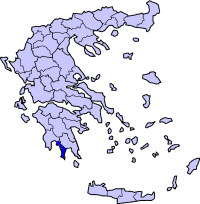Ottoman invasion of Mani (1770)
| 1770 Ottoman Invasion of Mani | |||||||||
|---|---|---|---|---|---|---|---|---|---|
| Part of the Orlov Revolt | |||||||||
 Map of Greece with Mani highlighted. | |||||||||
| |||||||||
| Belligerents | |||||||||
|
|
| ||||||||
| Commanders and leaders | |||||||||
|
Exarchos Grigorakos Tzanetos Grigorakos | Hadji Osman † | ||||||||
The 1770 Ottoman Invasion of Mani was one of a series of invasions by the Ottomans to subdue the Maniots. Mani was one region of Greece that the Ottomans had not occupied due to the rough terrain and the rebellious spirit of Maniots. The Maniots caused damage to the Ottomans by allying with the Venetians whenever there was a war between Venice and the Ottomans and they also were pirates.
After the failed Orlov Revolt of 1770 in which the Maniots took part, Turko-Albanians ravaged the Peloponnese and kept the Maniots cooped up inside Mani. The Turks also tried to keep the Maniots quiet by placing a bey who was a Maniot to govern them. In 1770 the Ottoman bey of the Peloponnese, Hassán Ghazi, saw his chance to invaded Mani and subjugate them once and for all.
With a large force of Turko-Albanians he penetrated into Mani and laid siege to the tower of the powerful Grigorakos of Ayeranos and Skoutari. The Grigorakos' tower held out for three days before being destroyed. The Ottomans then fought a battle against the Maniot army and lost and were forced to withdraw from Mani. The Maniots then sacked the Ottoman castle of Passavas on Easter Sunday.
Prelude
The failed Orlov Revolt of 1770 was a disaster for Mani. The Maniots were bottled up inside Mani and were forced to pay a tribute of 15,00 groshes to the Ottomans.[1] The Ottomans also appointed a Maniot bey to govern of the Maniots. The Ottomans sent parties of Turko-Albanians troops to raid Mani. The Maniots still caused some trouble for the Ottomans with their ships.
The Ottoman pasha of the Peloponnese, Hatzi Osman thought it was his chance to take over Mani once and for all and to impress the sultan. He gathered and large and seasoned group of Turko-Albanians soldiers to accompany him in his invasion of Mani. When the Maniots heard of the Ottoman preparations they gathered their army under the command Éxarchos Grigorakis and his nephew Tzanetos Grigorakos who were from the powerful clan of Ayeranos and Skoutari in the mountains above Parasyros and waited for the Ottomans to arrive.
Invasion
When the Ottoman fleet arrived at Gytheio, Ghazi sent his second in command Ali Bey with 10,000 men he advanced to Kastania to deal with the klephts Konstantinos Kolokotronis and Panagiotaros Venetsanakis.[2] The town was defended by 400 men, women and children who held out for twelve days before trying to break out. The Ottomans however found out and slaughtered the defenders, of whom only 100 escaped.[2]
The Ottomans then headed to Skoutari only to find it abandoned except for the Grigorakos' tower in the centre of the town which was garrisoned by fifteen men under the command of Yanis Katsanos.[3] The Ottomans laid siege to the tower, but were repulsed for the first three days by the small force. On the third night Ghazi, frustrated by not having captured the tower, had it undermined. Once the mine was completed, he loaded it with gunpowder, which he ignited, killing all the men in the tower.
The Ottoman army then proceeded to the plain between Parasyros and Skoutari which was called 'Agio Pigada' which means 'Holy Wells' because of the monastery on the hill above the plain being surrounded by wells. The Maniot army advance to Parasyros and sent three brothers as envoys to Ghazi. They demanded that Ghazi and his men retreat or they would face to fight the Maniot army. Seeing that his army outnumbered than the Maniot army, he responded by beheading the Maniots' envoys and sending their heads to the Maniots on silver plates.
The infuriated Maniot army charged down the hill, and before the Ottomans had a chance to prepare the Maniots were upon them. The ended in a rout with the Ottoman army suffering heavy casualties. The rest of the Ottoman army including Ghazi retreated. The Maniots had nowhere to bury so many corpses so they threw them down the wells. The plain later got the name 'Vromopigada' which means 'Dirty Wells'.
Aftermath
Ghazi sent an envoy to Éxarchos saying that he wanted to negotiate. The men met in Tripoli, Ghazi's capitol, but once Éxarchos arrived, Ghazi had him seized and hanged.[1] When Éxarchos' mother heard the news she was enfuriated.[1] On Easter Sunday when everyone in Skoutari was at church she started calling the men women for not avenging her son's death. So the men of Skoutari under the command of Zanet dressed up as priests went to the Ottoman castle of Passavas and asked the commander if they could come in and bless the castle.[1] The commander agreed and once all the men were inside they took out their hidden weapons and slaughtered everyone inside the walls. None of the Ottomans made it out alive.[1] After the massacre, Passavas was abandoned and never inhabited again. The Ottomans then tried to destroy Zanet in 1803 and 1807.[1] The Ottomans tried to subdue Mani again in 1815 by capturing Skoutari but the men of Skoutari beat back the attack and in 1821 the rest of Greece declared their independence from the Ottomans.
Notes
- 1 2 3 4 5 6 Greenhalgh and Eliopoulos. Deep into Mani: Journey to the Southern Tip of Greece.
- 1 2 Πουμελιώτη, Ηρωίδες της Λακωνίας και της Μάνης Όλης (1453–1944)
- ↑ Ramp,Mani
Sources
- Peter Greenhalgh and Edward Eliopoulos. Deep into Mani: Journey to the Southern Tip of Greece. ISBN 0-571-13524-2
- Philip Ramp. Mani.
- Γιάννη Χ. Πουμελιώτη. Ηρωίδες της Λακωνίας και της Μάνης Όλης (1453–1944). ΙSBN 960-87030-1-8